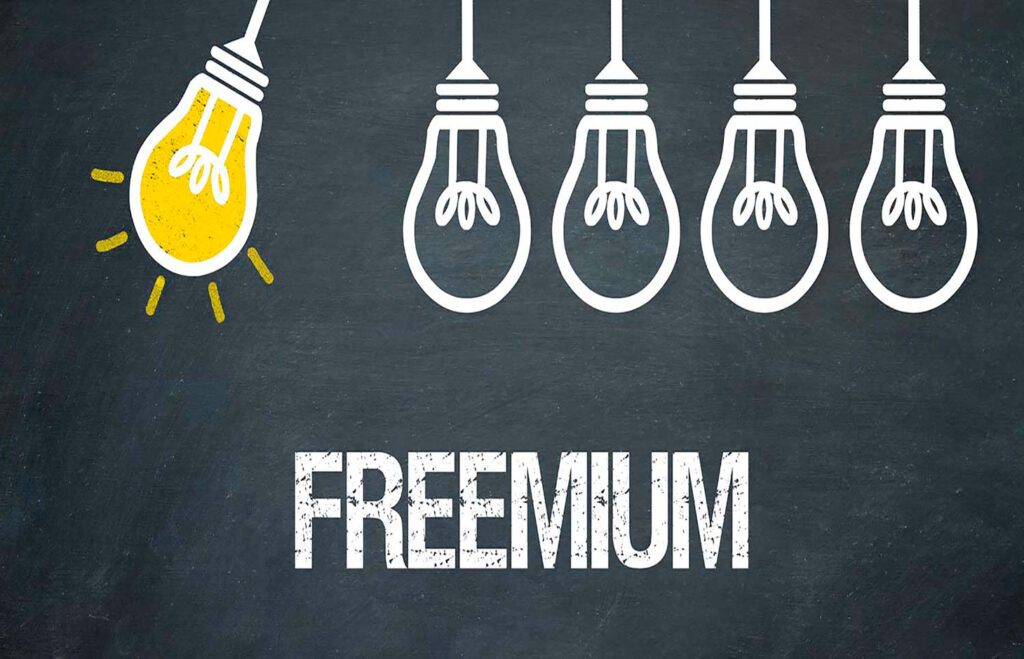If someone is willing to let you use a product that you need for free, how likely would you be to accept the offer?
Pretty likely, I bet. After all, it won’t cost you a cent!
Of course, there’s a catch. You won’t be getting full access to all of the product’s features. For that, you’d have to sign up for a paid subscription.
Once you get hooked on the free version of the product though, you may be a whole lot more likely to upgrade to paid compared to someone being asked to pay upfront for a product they’ve never used before.
This is exactly how a freemium pricing strategy works, and it’s growing in popularity among SaaS businesses.
Want proof? Well, any business needing help with working remotely during the pandemic can simply check out Entrepreneur’s massive list of 198 free SaaS tools. And of course, that’s just one list.
“Freemium once again feels cutting edge,” wrote Kyle Poyar, partner at venture capital firm OpenView Venture Partners, in an August 2020 blog post. This is a big change from his pessimism towards the pricing strategy in 2016, where he regarded freemium as dying a “slow death.”
“SaaS companies have gotten much smarter about when to apply a freemium model to their products—and how to do it,” Povar continued in his 2020 blog post.
“They also better understand how to measure the success of freemium and strategies to convert free users into paying customers.”
So, is introducing a freemium plan in your SaaS business’s future? What are the upsides, and what are some things you should keep in mind when adopting a freemium SaaS pricing strategy?
Is offering a freemium version of your SaaS product worth it?
You’re running a for-profit business, so it’s natural to feel some hesitation over going freemium, where you’ll be charging nothing—zero, zilch, nada—for your product.
Why then might using a freemium pricing strategy be a good idea?
The answer lies in the idea of product-led growth, where you leverage your product to gain and retain customers.
To do this, for example, you could first put your product in the hands of as many people as possible. Because as more people try your product, more of them are likely to find they benefit from it—and then happily convert to paying customers.
And what better way to incentivize people to try your product than by offering it for free?
Case in point.
Mailchimp is arguably one of the most well-known email marketing platforms out there. And it can probably attribute much of its success to its free plan, which it has offered for close to 12 years now.
While the business’s free plan has evolved over the years, when it first launched in 2009 it offered users:
- full access to all its features,
- an email list size of up to 500 subscribers, and
- the ability to send up to 3,000 emails per month.
Mailchimp’s efforts in going freemium didn’t take long to bear fruit, either. Just one year later, the business reported the following results:
- 30,000 new users and 4,000 new paying customers per month,
- 150% increase in paying customers, and
- 650% increase in profit (not revenue mind you, but profit).
When is your product a good fit for freemium pricing?
Excited about the potential of freemium now?
If you’re raring to go, the next question to consider is whether your SaaS product is suited for it in the first place. After all, you don’t want to offer your product for free, only for no one to upgrade to paid—or at least not enough customers to make it worthwhile.
In this regard, freemium pricing is a good choice for products with value propositions that are better appreciated when experienced firsthand.
If your product is a bit more complicated to understand, letting users test-drive it for free may help them grasp the value it provides. And these users could then be more persuaded to sign up for your paid offering.
This is exactly why automation platform Zapier decided to release a freemium version of its product. As Wade Foster, CEO and co-founder of Zapier, explained:
“So [Zapier’s product is] not something that people can wrap their head around immediately, they’re like, Oh, I know it’s providing integrations, but how does it work? What does this thing do? And so there’s a certain amount of like, I wanna play with this, and I wanna see what it can do,”
Offering a free plan certainly paid off for Zapier. The business now has over three million users, of which approximately 100,000 are paying customers. It has also achieved a cool $140 million in annual recurring revenue (ARR).
But freemium products aren’t free to maintain
Before you commit to launching a freemium SaaS offering, keep this in mind:
While users get to enjoy your product for free, maintaining it for their use—and providing customer support to these non-paying users—still comes at a cost to you.
How equipped is your business to handle an increase in product usage and support requests after you go freemium? And will the additional revenue you gain from product-led conversions (if any) be able to cover these extra costs?
Subscription analytics platform Baremetrics learned this the hard way when it decided to put out a freemium offering in 2015.
- Within just weeks of launching its free plan, the business had more free users than paying customers.
- It also had to store and process 2X the amount of data than before, which was way more than what it could handle.
- This caused server issues, which required more resources to fix. But while it was scrambling to resolve these, product development stalled.
- Additionally, having to support 3X the number of users—free and paid—also impacted the business’s responsiveness to support requests.
So what happens if your product is performing poorly due to technical issues and your users can’t get the support they need?
Customers start canceling.
During the 11 weeks where Baremetrics offered a free plan, the business suffered a net loss in customers and doubled revenue churn.
Reflecting on this episode two years later, founder Josh Pigford expressed his thoughts that the business’s foray into freemium might have turned out differently if it had imposed more limitations on its free plan, among other measures.
And although Pigford said he was “not going to write off freemium completely”, it seems Baremetrics has no immediate plans to reintroduce a free offering.
The business subsequently launched a 14-day free trial, which it continues to offer to this day.
Will your SaaS business adopt a freemium pricing strategy?
As seen from the successes of Mailchimp and Zapier—as well as many other heavy-hitters, such as Atlassian, Zoom, HootSuite and more—your SaaS business might just derive significant revenue gains from embracing a freemium pricing strategy. This is especially if users need to experience your product to get a better picture of how it works and how it can benefit them.
And even if your product is more intuitive in nature, offering a freemium version of it can be ideal for gaining more customers at lower customer acquisition costs (CAC).
After all, if you build your product into your marketing flywheel, and thereby adopt a product-led growth strategy, your product basically helps to sell itself.
However, be prepared to manage the influx of free users that will come with going freemium.
Helping your non-paying users achieve success with your product—even when there’s no guarantee they’ll convert—will place demands on your business’s resources and time.
You don’t want this to happen to the extent that paying customers suffer a diminished user experience and then churn.
But if you’ve decided going freemium is worth a shot, careful planning and execution will go a long way in helping you reap the rewards of a freemium SaaS pricing strategy—while also reducing the potential risks to your business.








